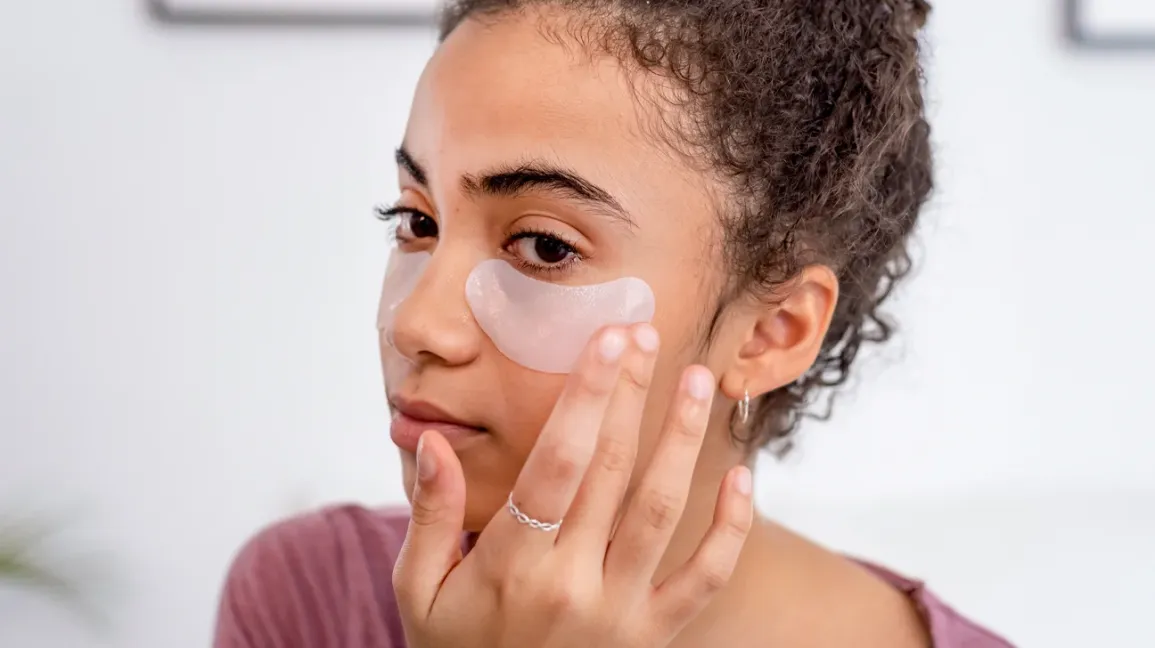Our eyes are a window: They can reveal when we haven’t gotten enough sleep, whether we had one too many drinks the night before, or how many times we’ve laughed in our lives.
That’s because the skin around the eyes is the thinnest on the face, making it more susceptible to irritation, dryness, and environmental damage that can lead to signs of aging.
That’s because the skin around the eyes doesn’t have as many sebaceous glands and collagen as the rest of the face and body, making it more susceptible to dryness, sagging, fine lines, and wrinkles, according to a 2015 study published in Advanced Biomedical Research.
To prevent these common eye problems, dermatologists recommend using specialized eye care products because they’re designed specifically for the delicate eye area.
“When treating skin problems around the eyes, it’s important to first correctly diagnose the problem so that the best treatment and results can be achieved,” says Dr. Joshua Zeichner, director of cosmetic and clinical research in the department of dermatology at Mount Sinai Hospital in New York City.
Fortunately, there are a variety of eye care products to choose from, including serums, creams, oils, and enhancers. So if you’ve never used an eye care product before, don’t worry—it’s never too late to start, and these pro tips will guide you to the best solution for your needs.
From fading dark circles to reducing puffiness, here are expert tips and product recommendations for treating common skin issues around the eyes.
Reduce fine lines and crow’s feet. Crow’s feet are a sign of a happy life. These horizontal wrinkles that form at the outer corners of the eyes are largely the result of muscle movement when smiling and laughing.
If you want to relieve these symptoms, “retinoid products can be very helpful,” says Ranela Hirsch, MD, a board-certified dermatologist in Cambridge, Massachusetts. Retinoids can stimulate collagen production in the skin, which can help smooth out some wrinkles.
Prescription retinoids such as 0.025% Tretinoin Cream are very effective, Dr. Hirsch recommends limiting yourself to the area outside the eye socket (where you can feel the surrounding orbital bone), however.
To treat fine lines under the eyes, you can try an over-the-counter eye cream with retinol, a less potent retinoid. Whether you use prescription or over-the-counter retinoids, start by massaging a small area one night a week and then gradually work your way up over several nights to limit dryness and irritation.
If you can’t tolerate retinoids, consider a peptide eye cream, which can also stimulate collagen production. Don’t forget to protect your skin with a broad-spectrum SPF of 50 or higher. (To avoid eye irritation, Dr. Hirsch recommends using a sunscreen that won’t get in your eyes.) Diminish Dark Circles Lack of sleep can make dark circles worse, but it’s usually not the primary cause. “The main cause of dark circles is hyperpigmentation of the skin and the hollows around the eyes that form with aging,” says Dr. Graphist. To determine the amount of exposure, stand in front of a mirror under a bright light. “Gently pinch a piece of dark skin and pull it forward slightly,” he advises. “If the skin is still dark, it’s a sign of hyperpigmentation. Dimples can create shadows around the eyes when the skin tone looks normal.” To combat dark circles caused by hyperpigmentation, Dr. Apply an eye cream with vitamin C to help reduce the production of melanin (also known as pigment) in your skin. Choose a formula that comes in a tube or pump bottle instead of a jar to preserve the potency of the ingredients and use it daily. “Think of vitamin C as exercise,” says Dr. Illustrator. “You need to stick with it for a few months before you see results.” Illustrator.
We have a deer ahead of us. Avoid rubbing your eyes, as prolonged rubbing can stimulate the production of more melanin, especially in skin types with heavy melanin. Cavities are another problem that occurs when the subcutaneous fat in the tear trough (the area between the lower eyelid and upper cheek) decreases with age, causing the trough to appear deeper and darker. “Eye creams enriched with hyaluronic acid can help plump up the skin,” explains Dr. Illustrator. To further improve the results, consider injectable fillers. Drinking water can also help—while the water you drink won’t directly moisturize your skin, the indentations in your skin are less noticeable when you’re well-hydrated.
Reduce puffiness Going to bed drunk or shedding a few tears can cause puffy eyes.
However, chronic eye swelling is often the result of allergies. If you suffer from seasonal allergies, properly used antihistamines can help control the swelling process. “You shouldn’t wait until symptoms appear to start taking them,” says Dr. Hirsch. “Ideally, take an antihistamine daily two weeks before a pollen outbreak so you can stay one step ahead of allergies.” Hirsch recommends buying hypoallergenic pillowcases: “This prevents household allergens from sticking to your pillow. Keep your pillows clean and free of allergens they may have. The effect is dramatic. “Prolonged exposure during sleep.” To resolve the problem immediately, use an eye cream with caffeine, an anti-inflammatory agent that helps constrict blood vessels and drain excess fluid from under the skin. You can also wear a pop-up eye mask to reduce puffiness or apply a cold compress to your eyes, as cold temperatures also constrict blood vessels. (Be sure to keep your head elevated to promote drainage.) “If you’re prone to puffiness, using a retinol eye cream daily will help tighten the skin and make the puffiness less noticeable,” says Dr. Deer. However, if you have a greasy-looking bump under your eye that won’t go away despite your best efforts, “it could be because of sagging cheek pads that can’t be treated with skincare, but are less noticeable.” “It can be achieved with injectable fillers or permanent fixation through surgery,” says Dr. Illustrator.
DQH Knowledge drop: In your 20s, your skin cell turnover decreases. (Cell turnover is a key component in keeping your skin youthful.) You know what else slows down? Your collagen production. Starting in your 20s, collagen decreases by about 1 percent per year. Should you want to prevent fine lines and wrinkles, start by eliminating behaviors that contribute to premature aging. “If it’s bad for you, it’s bad for your skin,” says dermatologist Michel Somenek.
“Cigarette smoking reduces blood flow to the skin and causes premature wrinkling and a dull skin texture. Making the repeated pursed motion to inhale can also cause smoker’s lines. Alcohol and recreational drugs are toxins for the skin that damage its cellular structure and DNA,” Somenek tells us. “The faster you eliminate vices while you are young, the better chance your skin and body have to recuperate.” Also, adopting an anti-aging routine in your 20s is key. After all, the best offense is a good defense. We spoke to Somenek and experts Joshua Ross and Audrey Kunin to find out more.
Keep reading for the best anti-aging products for your 20s, according to skincare professionals.
Sunscreen
“We all know that the sun is the number one cause of skin aging and starting the prevention in your 20s is very important,” Ross says. “The majority of your sun damage won’t start to appear until you’re in your 30s, so don’t wait until you see it surface or you’ll be behind the curve. Stay ahead of it with a good-quality zinc-based sunscreen worn daily.”
Farmacy Green Defense Daily Mineral Sunscreen
An invisible sunscreen with SPF 30, plus botanical extracts meant to protect skin with tons of antioxidants. Bonus: It’s clean and fine to use under makeup.
Bareminerals Complexion Rescue™ Tinted Moisturizer Broad Spectrum SPF 30
Although we recommend you use your SPF and moisturizer separately, we also understand moments when you don’t have time or energy for that extra step. For those times, this bareMinerals moisturizer is a great thing to have on hand.
Vitamin C Serum
“A great introduction to anti-aging is to start with a vitamin C serum in your morning skincare routine,” Ross says. “It’s a powerful antioxidant that will neutralize free radicals and brighten the skin.” He adds that it’s a great way to counteract the effects of the sun’s harmful rays, which, as previously mentioned, are among the biggest causes of premature aging.
Drunk Elephant C-Firma™ Vitamin C Day Serum
The Drunk Elephant C-Firma is a lightweight serum that promises to give skin a glow by combining the brightening powers of vitamin C with ferulic acid, l-ascorbic acid, and vitamin E. The included sodium hyaluronate is meant to replace hydration loss, so you shouldn’t have to deal with any irritation.
Sunday Riley C.E.O. Rapid Flash Brightening Serum
This potent serum is jam-packed with vitamin C (15 percent, to be exact), which means it’s a potential superstar at both brightening skin and dousing it in antioxidants.
Peptides
Using peptides on your skin has many benefits, says Somenek. “The skin barrier is what defends the body against pollution, UV rays, bacteria, and toxins. It can be damaged by several everyday factors. Using topical peptides aids in building a stronger barrier,” he says. “Peptides comprise elastic fibers, which are a type of protein. These fibers help to make skin appear taut and firm. Peptides can also help repair damaged skin, relieve inflammation, and even out skin tone. Some peptides can kill acne-causing bacteria that is common in 20-somethings.”
Kunin agrees, saying, “Peptides are an excellent entry point for supporting collagen.” She recommends looking for face and eye treatments that contain these collagen-boosting powerhouses.
Charlotte Tilbury Magic Eye Rescue Cream
This Charlotte Tilbury super-emollient eye cream has a base of coconut oil and shea butter (read: it’s incredibly hydrating). Botanicals plus peptides are meant to help reduce dark circles and boost collagen, respectively.
This creamy moisturizer serves up potent collagen-boosting peptides and pycnogenol, and antioxidant-rich vitamin C. “Instead of sitting on top of the skin, peptides penetrate the outer layer so they go deep. The ‘signals’ they send tell the cells to produce elastin and collagen, which are needed for youthful-looking skin,” explains Somenek.
At-Home Peel Pads
Remember that skin cell turnover fiasco we talked about earlier? One way to help support it is by exfoliating. “Exfoliation is important to help keep skin fresh and luminous,” Kunin says. She recommends using at-home peel pads as an easy and effective way to exfoliate.
“The goal in your 20s is to fight the slowing pace of cell turnover. It is wise to use products that gently exfoliate, yet still remove oil and other impurities. Products that have Alpha Hydroxy Acids (AHA) or Beta Hydroxy Acids (BHA) are a good choice.”
According to Somenek, you should only exfoliate two to three times a week. “People of all ages are guilty of over-exfoliating and that can be too much of a good thing,” he says.
Dermadoctor Kakadu C Intensive Vitamin C Peel Pad
A few swipes of this Derma Doctor powerful peel pad promise to leave your skin glowing and smooth, thanks to the seven (yes, seven) types of chemical exfoliants, including AHA and BHA. It also contains vitamin C via Kakadu plum extract for added brightening and antioxidant protection.
KEY INGREDIENTS Kakadu plum extract is sourced from the Kakadu plum, a fruit grown in northern Australia. It contains vitamin C, which restores the skin’s natural barrier, increases collagen production, and soothes irritation.
Dr. Dennis Gross Skincare Alpha Beta® Universal Daily Peel Pads
These are the gold standard of peel pads, with a cult following and over 900 five-star reviews on Sephora. They’re easy to use and contain a blend of anti-aging exfoliating acids.
Emollient Night Cream
“In your 20s, you need to start upping the hydration in your skincare routine. You may have been cautious of over-moisturizing because of acne in your teens, but as you enter your 20s, your skin transitions and becomes drier,” Ross says. “I recommend an emollient night cream added into your evening skincare regimen.”
“Twenty-somethings need to make sure that they are not using creams that will clog their pores and cause excess oil production,” says Somenek. Opt for non-comedogenic products.
Cerave Skin Renewing Night Cream
One great choice is the CeraVe Skin Renewing Night Cream, which is a non-comedogenic night cream that leaves skin soft and glowy. It combines the moisturizing powers of ceramides and hyaluronic acid.
RoC Retinol Correxion Max Hydration Creme
“The best night cream ingredients contain retinol, benzoyl peroxide, and/or salicylic acid or hyaluronic acid. The goal is to moisturize, yet remove excess oil,” says Somenek. This Roc Retinol Correxion cream fits the bill as it contains both hyaluronic acid and retinol so it promises to moisturize while also being non-comedogenic.



